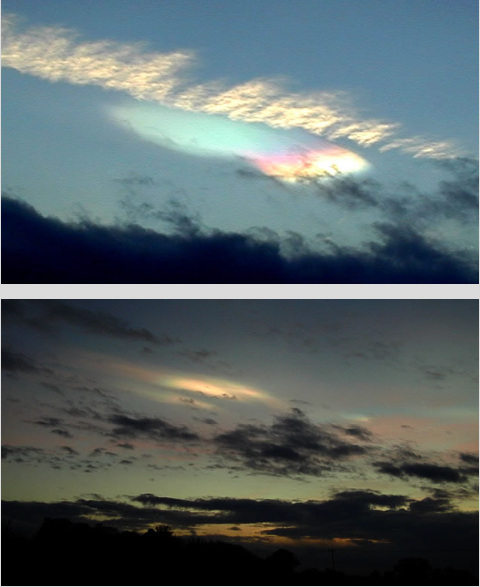Nacreous Clouds - England
Nacreous Clouds - England: A Rare Atmospheric Phenomenon
Nacreous clouds, also known as polar stratospheric clouds (PSCs), are a captivating and rare atmospheric phenomenon that typically occur at high latitudes. However, on a few remarkable occasions, these ethereal clouds have been spotted over England, adding a touch of magic to the skies. Despite the relatively lower latitude, nacreous clouds have graced the English horizon at least twice since 1996, leaving onlookers in awe of their beauty.
One such extraordinary sighting took place on January 29th, 2000, when a gale was blowing and the sun was setting. Against this dramatic backdrop, a nacreous cloud illuminated the heavens like an electric discharge. Towering between 15 and 25 kilometers above the Earth's surface, these clouds stood high above the nearby creamy-colored cirrus clouds and the dark storm clouds, creating a stunning contrast.
What made this sighting even more remarkable was that nearly half an hour later, the high nacreous clouds were still basking in the sunlight. The lingering presence of these radiant clouds added to the enchantment of the moment, capturing the imagination of those fortunate enough to witness this extraordinary display.
Nacreous clouds are formed in the stratosphere, a layer of the Earth's atmosphere located between 10 and 50 kilometers above the surface. They are composed of tiny ice crystals that reflect and refract sunlight, resulting in their distinctive iridescent colors. These unique hues range from vibrant pinks and purples to soft blues and greens, creating a mesmerizing spectacle against the sky.
The formation of nacreous clouds requires specific atmospheric conditions. Typically, they occur in polar regions during winter when the stratosphere is exceptionally cold. However, occasionally, these conditions can extend to lower latitudes, allowing nacreous clouds to grace regions like England with their presence.
Nacreous clouds are often associated with the polar vortex, a large-scale cyclonic circulation in the polar stratosphere. This atmospheric phenomenon brings extremely cold air from the polar regions towards lower latitudes, creating the frigid temperatures necessary for nacreous cloud formation. When these icy conditions combine with the right amount of moisture and sunlight, it sets the stage for the creation of these magnificent clouds.
Although nacreous clouds are a sight to behold, they are also a reminder of the fragility of our atmosphere. These clouds are closely linked to the depletion of ozone in the stratosphere, particularly the occurrence of the infamous Antarctic ozone hole. Chemical reactions involving chlorofluorocarbons (CFCs) and other ozone-depleting substances contribute to the destruction of ozone molecules, creating conditions conducive to nacreous cloud formation.
In addition to their aesthetic appeal, nacreous clouds also have scientific significance. Scientists study these clouds to better understand the complex dynamics of the stratosphere and its interaction with various atmospheric phenomena. By analyzing the composition and properties of nacreous clouds, researchers gain insights into atmospheric processes and can refine climate models to improve our understanding of global climate change.
While nacreous clouds over England remain a relatively rare occurrence, their appearance serves as a testament to the ever-changing and awe-inspiring nature of our atmosphere. These ephemeral masterpieces remind us to look up and appreciate the beauty that unfolds above us, even in unexpected places. So, keep your eyes on the sky, for you never know when the heavens may unveil their breathtaking secrets.

Nacreous clouds do occur at lower latitudes, they have been visible over England at least twice since 1996.
A gale was blowing and the sun was setting on January 29th 2000 as this nacreous cloud glowed like an electric discharge.
It was likely 15-25 km high and far above the apparently close by creamy coloured cirrus cloud and the dark storm clouds.
Nearly half an hour later the high nacreous clouds were still in sunlight.
Photos � Les Cowley.
Note: this article has been automatically converted from the old site and may not appear as intended. You can find the original article here.
Reference Atmospheric Optics
If you use any of the definitions, information, or data presented on Atmospheric Optics, please copy the link or reference below to properly credit us as the reference source. Thank you!
-
<a href="https://atoptics.co.uk/blog/nacreous-clouds-england/">Nacreous Clouds - England</a>
-
"Nacreous Clouds - England". Atmospheric Optics. Accessed on November 24, 2024. https://atoptics.co.uk/blog/nacreous-clouds-england/.
-
"Nacreous Clouds - England". Atmospheric Optics, https://atoptics.co.uk/blog/nacreous-clouds-england/. Accessed 24 November, 2024
-
Nacreous Clouds - England. Atmospheric Optics. Retrieved from https://atoptics.co.uk/blog/nacreous-clouds-england/.